Changes in the Impacts of Topographic Factors, Soil Texture, and Cropping Systems on Topsoil Chemical Properties in the Mountainous Areas of the Subtropical Monsoon Region from 2007 to 2017: A Case Study in Hefeng, China
Abstract
1. Introduction
2. Materials and Methods
2.1. Study Area
2.2. Sampling Design and Laboratory Analyses
2.3. Data Analysis
2.3.1. Descriptive Statistics and Difference Tests
2.3.2. Geostatistical Analysis
- (1)
- Semivariance
- (2)
- Spatial Autocorrelation
- (3)
- Fractal Dimensions
- (4)
- Spatial Interpolation
3. Results
3.1. Descriptive Statistics and Difference Tests
3.1.1. Descriptive Statistics
3.1.2. Pearson’s Correlation between Topographic Factors and Soil Chemical Properties in Hefeng
3.1.3. Soil Chemical Properties in Different Soil Texture
3.1.4. Soil Chemical Properties in the Different Cropping Systems
3.2. Geostatistical Analysis
3.2.1. Semivariogram and Spatial Autocorrelation
3.2.2. Spatial Distribution of Soil Properties
- (1)
- Spatial Distribution of Soil Organic Matter in 2007 and 2017
- (2)
- Spatial Distribution of AP in 2007 and 2017
- (3)
- Spatial Distribution of Soil AK in 2007 and 2017
- (4)
- Spatial Distribution of Soil pH in 2007 and 2017
4. Discussion
4.1. Possible Reasons for Soil Chemical Property Changes
4.2. Suggestions for Local Farming Management
4.2.1. Moderate Use of Fertilizer
4.2.2. Crop Selection According to Soil Suitability and Topographic Factors
4.2.3. Construction of Water Conservancy Facilities
5. Conclusions
Author Contributions
Funding
Institutional Review Board Statement
Informed Consent Statement
Data Availability Statement
Conflicts of Interest
References
- Bogunovic, I.; Pereira, P.; Brevik, E.C. Spatial Distribution of Soil Chemical Properties in an Organic Farm in Croatia. Sci. Total Environ. 2017, 584–585, 535–545. [Google Scholar] [CrossRef] [PubMed]
- Fitter, A.H.; Gilligan, C.A.; Hollingworth, K.; Kleczkowski, A.; Twyman, R.M.; Pitchford, J.W. Biodiversity and Ecosystem Function in Soil. Funct. Ecol. 2005, 19, 369–377. [Google Scholar] [CrossRef]
- Goovaerts, P. Geostatistical Tools for Characterizing the Spatial Variability of Microbiological and Physico-Chemical Soil Properties. Biol. Fertil. Soils 1998, 27, 315–334. [Google Scholar] [CrossRef]
- Thapa, G.B.; Yila, O.M. Farmers’ Land Management Practices and Status of Agricultural Land in the Jos Plateau, Nigeria. Land Degrad. Dev. 2012, 23, 263–277. [Google Scholar] [CrossRef]
- Zhao, M.S.; Zhang, G.L.; Li, D.C.; Zhao, Y.G.; Wang, D.C. Spatial Variability of Soil Organic Matter and Factor Analysis in the South of Middle Jiangsu Plain. Sci. Geogr. Sin. 2013, 33, 83–89. [Google Scholar] [CrossRef]
- Keesstra, S.D.; Bouma, J.; Wallinga, J.; Tittonell, P.; Smith, P.; Cerdà, A.; Montanarella, L.; Quinton, J.N.; Pachepsky, Y.; Van Der Putten, W.H. The Significance of Soils and Soil Science towards Realization of the United Nations Sustainable Development Goals. Soil 2016, 2, 111–128. [Google Scholar] [CrossRef]
- Guo, J.H.; Liu, X.J.; Zhang, Y.; Shen, J.L.; Han, W.X.; Zhang, W.F.; Christie, P.; Goulding, K.W.T.; Vitousek, P.M.; Zhang, F.S. Significant Acidification in Major Chinese Croplands. Science 2010, 327, 1008–1010. [Google Scholar] [CrossRef]
- Williams, P.N.; Lei, M.; Sun, G.; Huang, Q.; Lu, Y.; Deacon, C.; Meharg, A.A.; Zhu, Y.-G. Occurrence and Partitioning of Cadmium, Arsenic and Lead in Mine Impacted Paddy Rice: Hunan, China. Environ. Sci. Technol. 2009, 43, 637–642. [Google Scholar] [CrossRef]
- Teng, Y.; Wu, J.; Lu, S.; Wang, Y.; Jiao, X.; Song, L. Soil and Soil Environmental Quality Monitoring in China: A Review. Environ. Int. 2014, 69, 177–199. [Google Scholar] [CrossRef]
- Bai, Z.; Caspari, T.; Gonzalez, M.R.; Batjes, N.H.; Mäder, P.; Bünemann, E.K.; de Goede, R.; Brussaard, L.; Xu, M.; Ferreira, C.S.S. Effects of Agricultural Management Practices on Soil Quality: A Review of Long-Term Experiments for Europe and China. Agric. Ecosyst. Environ. 2018, 265, 1–7. [Google Scholar] [CrossRef]
- Chen, S.; Lin, B.; Li, Y.; Zhou, S. Spatial and Temporal Changes of Soil Properties and Soil Fertility Evaluation in a Large Grain-Production Area of Subtropical Plain, China. Geoderma 2020, 357, 113937. [Google Scholar] [CrossRef]
- Guo, L.; Sun, Z.; Ouyang, Z.; Han, D.; Li, F. A Comparison of Soil Quality Evaluation Methods for Fluvisol along the Lower Yellow River. Catena 2017, 152, 135–143. [Google Scholar] [CrossRef]
- Herweg, K.; Ludi, E. The Performance of Selected Soil and Water Conservation Measures—Case Studies from Ethiopia and Eritrea. CATENA 1999, 36, 99–114. [Google Scholar] [CrossRef]
- Tian, D.; Niu, S. A Global Analysis of Soil Acidification Caused by Nitrogen Addition. Environ. Res. Lett. 2015, 10, 024019. [Google Scholar] [CrossRef]
- Sun, B.; Zhou, S.; Zhao, Q. Evaluation of Spatial and Temporal Changes of Soil Quality Based on Geostatistical Analysis in the Hill Region of Subtropical China. Geoderma 2003, 115, 85–99. [Google Scholar] [CrossRef]
- Guo, S.; Han, X.; Li, H.; Wang, T.; Tong, X.; Ren, G.; Feng, Y.; Yang, G. Evaluation of Soil Quality along Two Revegetation Chronosequences on the Loess Hilly Region of China. Sci. Total Environ. 2018, 633, 808–815. [Google Scholar] [CrossRef]
- Wu, C.; Liu, G.; Huang, C.; Liu, Q. Soil Quality Assessment in Yellow River Delta: Establishing a Minimum Data Set and Fuzzy Logic Model. Geoderma 2019, 334, 82–89. [Google Scholar] [CrossRef]
- Agriculture and Rural Bureau of Hefeng. The Report of Cultivated Land Survey and Evaluation in Hefeng; Agriculture and Rural Bureau of Hefeng: Hefeng, China, 2017.
- CMDC China Meteorological Data Service Center. Available online: http://data.cma.cn/ (accessed on 8 July 2019).
- Agriculture and Rural Bureau of Hefeng. The Report of Soil Fertility Evaluation in Hefeng; Agriculture and Rural Bureau of Hefeng: Hefeng, China, 2009.
- Olsen, S.R. Estimation of Available Phosphorus in Soils by Extraction with Sodium Bicarbonate; US Department of Agriculture: Washington, DC, USA, 1954.
- ISSCAS; IoSS. Chinese Academy Sciences Methods of Soil Physical and Chemical Analysis; Shanghai Science and Technology Press: Shanghai, China, 1978; pp. 250–380. [Google Scholar]
- Soil Survey Staff. Soil Taxonomy: A Basic System of Soil Classification for Making and Interpreting Soil Surveys; Soil Conservation Service, US Department of Agriculture: Washington, DC, USA, 1975; ISBN 0065-4612.
- Hodge, V.; Austin, J. A Survey of Outlier Detection Methodologies. Artif. Intell. Rev. 2004, 22, 85–126. [Google Scholar] [CrossRef]
- Gaur, A.S.; Gaur, S.S. Statistical Methods for Practice and Research: A Guide to Data Analysis Using SPSS; Sage: Thousand Oaks, CA, USA, 2006; ISBN 0-7619-3502-9. [Google Scholar]
- Understanding Curvature Rasters. Available online: https://www.esri.com/arcgis-blog/products/product/imagery/understanding-curvature-rasters/ (accessed on 17 December 2020).
- ESRI. ArcGIS Desktop (Version 10.7). Available online: https://desktop.arcgis.com/en/arcmap/10.7/get-started/setup/arcgis-desktop-quick-start-guide.htm (accessed on 17 December 2020).
- Zevenbergen, L.W.; Thorne, C.R. Quantitative Analysis of Land Surface Topography. Earth Surf. Process. Landf. 1987, 12, 47–56. [Google Scholar] [CrossRef]
- Rabus, B.; Eineder, M.; Roth, A.; Bamler, R. The Shuttle Radar Topography Mission—A New Class of Digital Elevation Models Acquired by Spaceborne Radar. ISPRS J. Photogramm. Remote Sens. 2003, 57, 241–262. [Google Scholar] [CrossRef]
- Fry, J.C. One-Way Analysis of Variance. Biol. Data Anal. Pract. Approach 1993, 1, 3–39. [Google Scholar]
- Ho, R. Handbook of Univariate and Multivariate Data Analysis and Interpretation with SPSS; CRC Press: Boca Raton, FL, USA, 2006; ISBN 1-4200-1111-1. [Google Scholar]
- Gamma Design Software GS+ Geoestatistics for the Environmental Sciences, Ver. 9.0. Available online: http://www.sciencesoftware.com.cn/NewSoftware_detail.aspx?sid=105 (accessed on 17 December 2020).
- Isaaks, E.H.; Srivastava, M.R. Applied Geostatistics; Oxford University Press: Oxford, UK, 1989; ISBN 0-19-505012-6. [Google Scholar]
- Getis, A. Spatial Autocorrelation. In Handbook of Applied Spatial Analysis; Springer: Berlin, Germany, 2010; pp. 255–278. [Google Scholar]
- Levi, M.R.; Rasmussen, C. Covariate Selection with Iterative Principal Component Analysis for Predicting Physical Soil Properties. Geoderma 2014, 219, 46–57. [Google Scholar] [CrossRef]
- Anderson, A.N.; McBratney, A.B.; Crawford, J.W. Applications of Fractals to Soil Studies. In Advances in Agronomy; Elsevier: Amsterdam, The Netherlands, 1997; Volume 63, pp. 1–76. ISBN 0065-2113. [Google Scholar]
- Burrough, P.A. Fractal Dimensions of Landscapes and Other Environmental Data. Nature 1981, 294, 240–242. [Google Scholar] [CrossRef]
- Goovaerts, P. Geostatistics in Soil Science: State-of-the-Art and Perspectives. Geoderma 1999, 89, 1–45. [Google Scholar] [CrossRef]
- Ha, H.; Olson, J.R.; Bian, L.; Rogerson, P.A. Analysis of Heavy Metal Sources in Soil Using Kriging Interpolation on Principal Components. Environ. Sci. Technol. 2014, 48, 4999–5007. [Google Scholar] [CrossRef]
- Burgess, T.M.; Webster, R. Optimal Interpolation and Isarithmic Mapping of Soil Properties: I The Semi-variogram and Punctual Kriging. J. Soil Sci. 1980, 31, 315–331. [Google Scholar] [CrossRef]
- Liu, T.-L.; Juang, K.-W.; Lee, D.-Y. Interpolating Soil Properties Using Kriging Combined with Categorical Information of Soil Maps. Soil Sci. Soc. Am. J. 2006, 70, 1200–1209. [Google Scholar] [CrossRef]
- Chai, T.; Draxler, R.R. Root Mean Square Error (RMSE) or Mean Absolute Error (MAE)? GMDD 2014, 7, 1525–1534. [Google Scholar] [CrossRef]
- Liang, Z.; Chen, S.; Yang, Y.; Zhao, R.; Shi, Z.; Rossel, R.A.V. National Digital Soil Map of Organic Matter in Topsoil and Its Associated Uncertainty in 1980’s China. Geoderma 2019, 335, 47–56. [Google Scholar] [CrossRef]
- Shi, X.Z.; Yu, D.S.; Warner, E.D.; Pan, X.Z.; Petersen, G.W.; Gong, Z.G.; Weindorf, D.C. Soil Database of 1: 1,000,000 Digital Soil Survey and Reference System of the Chinese Genetic Soil Classification System. Soil Surv. Horiz. 2004, 45, 129–136. [Google Scholar] [CrossRef]
- Shangguan, W.; Dai, Y.; Liu, B.; Ye, A.; Yuan, H. A Soil Particle-Size Distribution Dataset for Regional Land and Climate Modelling in China. Geoderma 2012, 171, 85–91. [Google Scholar] [CrossRef]
- Yuan, P.; Wang, J.; Li, C.; Xiao, Q.; Liu, Q.; Sun, Z.; Wang, J.; Cao, C. Soil Quality Indicators of Integrated Rice-Crayfish Farming in the Jianghan Plain, China Using a Minimum Data Set. Soil Tillage Res. 2020, 204, 104732. [Google Scholar] [CrossRef]
- Huang, J.; Lin, T.-C.; Xiong, D.; Yang, Z.; Liu, X.; Chen, G.; Xie, J.; Li, Y.; Yang, Y. Organic Carbon Mineralization in Soils of a Natural Forest and a Forest Plantation of Southeastern China. Geoderma 2019, 344, 119–126. [Google Scholar] [CrossRef]
- Zhao, K.; Zhang, L.; Dong, J.; Wu, J.; Ye, Z.; Zhao, W.; Ding, L.; Fu, W. Risk Assessment, Spatial Patterns and Source Apportionment of Soil Heavy Metals in a Typical Chinese Hickory Plantation Region of Southeastern China. Geoderma 2020, 360, 114011. [Google Scholar] [CrossRef]
- Zhang, Y.; Li, L.; Wang, X.; Lu, J. Temporal and Spatial Variation of Soil PH in Henan. Chin. J. Soil Sci. 2019, 50, 1091–1100. [Google Scholar]
- Zhang, J.; Li, F.; Hu, K.; Zhang, Q.; Guo, C.; Huang, Y. Spatial Characteristics and Impact Factors of Soil Total Nitrogen and Soil Organic Matter in Taiyuan. Acta Ecol. Sin. 2009, 29, 6. [Google Scholar]
- Yang, Z.; Yu, T.; Hou, Q.; Xia, X.; Feng, H.; Huang, C.; Wang, L.; Lv, Y.; Zhang, M. Geochemical Evaluation of Land Quality in China and Its Applications. J. Geochem. Explor. 2014, 139, 122–135. [Google Scholar] [CrossRef]
- Hillel, D. Applications of Soil Physics; Academic Press: New York, NY, USA, 1980. [Google Scholar]
- Behera, B.K.; Bera, A.K.; Paria, P.; Das, A.; Parida, P.K.; Kumari, S.; Bhowmick, S.; Das, B.K. Identification and Pathogenicity of Plesiomonas Shigelloides in Silver Carp. Aquaculture 2018, 493, 314–318. [Google Scholar] [CrossRef]
- Kihanda, F.M.; Warren, G.P.; Micheni, A.N. Effects of Manure Application on Crop Yield and Soil Chemical Properties in a Long-Term Field Trial in Semi-Arid Kenya; Springer: Dordrecht, The Netherlands, 2007; pp. 471–486. [Google Scholar]
- Wu, J.; Liang, G.; Hui, D.; Deng, Q.; Xiong, X.; Qiu, Q.; Liu, J.; Chu, G.; Zhou, G.; Zhang, D. Prolonged Acid Rain Facilitates Soil Organic Carbon Accumulation in a Mature Forest in Southern China. Sci. Total Environ. 2016, 544, 94–102. [Google Scholar] [CrossRef]
- Qi, Y.; Chang, Q.; Liu, M.; Liu, J.; Chen, T. County-Scale Spatial Variability of Soil Nutrient Distribution and Determination of Reasonable Sampling Density. Chin. J. Soil Sci. 2014, 45, 556–561. [Google Scholar] [CrossRef]
- Agricultural Bureau of Hefeng County. Cultivated Land Quality Evaluation; Soil and Fertilizer Workstation in Hubei Province; National Ministry of Agriculture and Rural Development: Beijing, China, 2010.
- Fang, Y.; Haiming, L. Research on Spatial Variability of Soil Organic Matter in Hubei Province Based on Geostatistics and GIS. Jiangsu Agric. Sci. 2019, 45, 282–286. [Google Scholar] [CrossRef]
- Hubei Bureau of Statistics. The Yearbook of Enshi Tujia and Miao Autonomous Prefecture; Changjiang Publishing Media Hubei People’s Publishing House: Wuhan, China, 2008. [Google Scholar]
- Hubei Bureau of Statistics. The Yearbook of Enshi Tujia and Miao Autonomous Prefecture; Changjiang Publishing Media Hubei People’s Publishing House: Wuhan, China, 2018. [Google Scholar]
- Campbell, C.A.; Biederbeck, V.O.; McConkey, B.G.; Curtin, D.; Zentner, R.P. Soil Quality—Effect of Tillage and Fallow Frequency. Soil Organic Matter Quality as Influenced by Tillage and Fallow Frequency in a Silt Loam in Southwestern Saskatchewan. Soil Biol. Biochem. 1998, 31, 1–7. [Google Scholar] [CrossRef]
- Schnürer, J.; Clarholm, M.; Rosswall, T. Microbial Biomass and Activity in an Agricultural Soil with Different Organic Matter Contents. Soil Biol. Biochem. 1985, 17, 611–618. [Google Scholar] [CrossRef]
- Department of Agriculture and Rural Affairs of Hubei. Highlights of Soil Fertilizer Work in 2009. Available online: http://nyt.hubei.gov.cn/zfxxgk/fdzdgknr_GK2020/ghxx_GK2020/ndjhyzj_GK2020/202009/t20200908_2898185.shtml (accessed on 29 December 2020).
- Jiang, L.; Deng, X.; Seto, K.C. The Impact of Urban Expansion on Agricultural Land Use Intensity in China. Land Use Policy 2013, 35, 33–39. [Google Scholar] [CrossRef]
- Wu, Y.; Xi, X.; Tang, X.; Luo, D.; Gu, B.; Lam, S.K.; Vitousek, P.M.; Chen, D. Policy Distortions, Farm Size, and the Overuse of Agricultural Chemicals in China. Proc. Natl. Acad. Sci. USA 2018, 115, 7010–7015. [Google Scholar] [CrossRef]
- Keesstra, S.; Pereira, P.; Novara, A.; Brevik, E.C.; Azorin-Molina, C.; Parras-Alcántara, L.; Jordán, A.; Cerdà, A. Effects of Soil Management Techniques on Soil Water Erosion in Apricot Orchards. Sci. Total Environ. 2016, 551–552, 357–366. [Google Scholar] [CrossRef]
- Liu, Z.; Zhou, W.; Shen, J.; He, P.; Lei, Q.; Liang, G. A Simple Assessment on Spatial Variability of Rice Yield and Selected Soil Chemical Properties of Paddy Fields in South China. Geoderma 2014, 235–236, 39–47. [Google Scholar] [CrossRef]
- Yan, W.; Fan, J.; Chen, G.; Zhang, J. The spatial concentration of phosphorus mineral resources and industrial layout in Hubei Province. Contrib. Geol. Miner. Resour. Res. 2015, 30, 103–110. [Google Scholar] [CrossRef]
- Lv, Y.; Cao, J.; Wang, Z. The Formation of Environmental Pollution in Phosphate Mines and Its Prevention. Conserv. Util. Miner. Resour. 2002, 6. [Google Scholar] [CrossRef]
- Zhang, H.; Xu, M.; Shi, X.; Li, Z.; Huang, Q.; Wang, X. Rice Yield, Potassium Uptake and Apparent Balance under Long-Term Fertilization in Rice-Based Cropping Systems in Southern China. Nutr. Cycl. Agroecosyst. 2010, 88, 341–349. [Google Scholar] [CrossRef]
- Hubei Bureau of Statistics. Agricultural Bureau of Hefeng County Arable Land Quality Survey and Evaluation in Hefeng County (2017); National Ministry of Agriculture and Rural Development: Beijing, China, 2018.
- Alam, S.M.; Naqvi, S.S.M.; Ansari, R. Handbook of Plant and Crop Stress; CRC Press: Boca Raton, FL, USA, 1999. [Google Scholar]
- Wang, M.; Liu, M.; Wang, K.; Liu, J. Analysis of variation of acid rain in Hubei during 2007 to 2014. Meteorol. Mon. 2016, 42, 857–864. [Google Scholar] [CrossRef]
- Ji, X.; Shen, Q.; Liu, F.; Ma, J.; Xu, G.; Wang, Y.; Wu, M. Antibiotic Resistance Gene Abundances Associated with Antibiotics and Heavy Metals in Animal Manures and Agricultural Soils Adjacent to Feedlots in Shanghai; China. J. Hazard. Mater. 2012, 235, 178–185. [Google Scholar] [CrossRef] [PubMed]
- Seiler, C.; Berendonk, T.U. Heavy Metal Driven Co-Selection of Antibiotic Resistance in Soil and Water Bodies Impacted by Agriculture and Aquaculture. Front. Microbiol. 2012, 3, 399. [Google Scholar] [CrossRef] [PubMed]
- Chan, K.Y.; Conyers, M.K.; Scott, B.J. Improved Structural Stability of an Acidic Hardsetting Soil Attributable to Lime Application. Commun. Soil Sci. Plant Anal. 2007, 38, 2163–2175. [Google Scholar] [CrossRef]
- Xu, R.; Zhao, A.; Yuan, J.; Jiang, J. PH Buffering Capacity of Acid Soils from Tropical and Subtropical Regions of China as Influenced by Incorporation of Crop Straw Biochars. J. Soils Sediments 2012, 12, 494–502. [Google Scholar] [CrossRef]
- Lou, Y.; Xu, M.; Wang, W.; Sun, X.; Zhao, K. Return Rate of Straw Residue Affects Soil Organic C Sequestration by Chemical Fertilization. Soil Tillage Res. 2011, 113, 70–73. [Google Scholar] [CrossRef]
- Liu, B.; Wu, Q.; Wang, F.; Zhang, B. Is Straw Return-to-Field Always Beneficial? Evidence from an Integrated Cost-Benefit Analysis. Energy 2019, 171, 393–402. [Google Scholar] [CrossRef]
- Han, T.; Cai, A.; Liu, K.; Huang, J.; Wang, B.; Li, D.; Qaswar, M.; Feng, G.; Zhang, H. The Links between Potassium Availability and Soil Exchangeable Calcium, Magnesium, and Aluminum Are Mediated by Lime in Acidic Soil. J. Soils Sediments 2019, 19, 1382–1392. [Google Scholar] [CrossRef]
- Hou, D.; Li, F. Complexities Surrounding China’s Soil Action Plan. Land Degrad. Dev. 2017, 28, 2315–2320. [Google Scholar] [CrossRef]
- McLean, E.O. Soil PH and Lime Requirement. Methods Soil Anal. Part 2 Chem. Microbiol. Prop. 1983, 9, 199–224. [Google Scholar]
- Liu, G.; Hanlon, E. Soil PH Range for Optimum Commercial Vegetable Production; University of Florida Department of Horticultural Sciences: Gainesville, FL, USA, 2012. [Google Scholar]
- Hazarika, M.K.; Honda, K. Estimation of Soil Erosion Using Remote Sensing and GIS: Its Valuation and Economic Implications on Agricultural Production. In Sustaining the Global Farm, Proceedings of the 10th International Soil Conservation Organization Meeting, West Lafayette, IN, USA, 24–29 May 1999; Purdue University: West Lafayette, IN, USA, 2001; Volume 1, pp. 1090–1093. [Google Scholar]
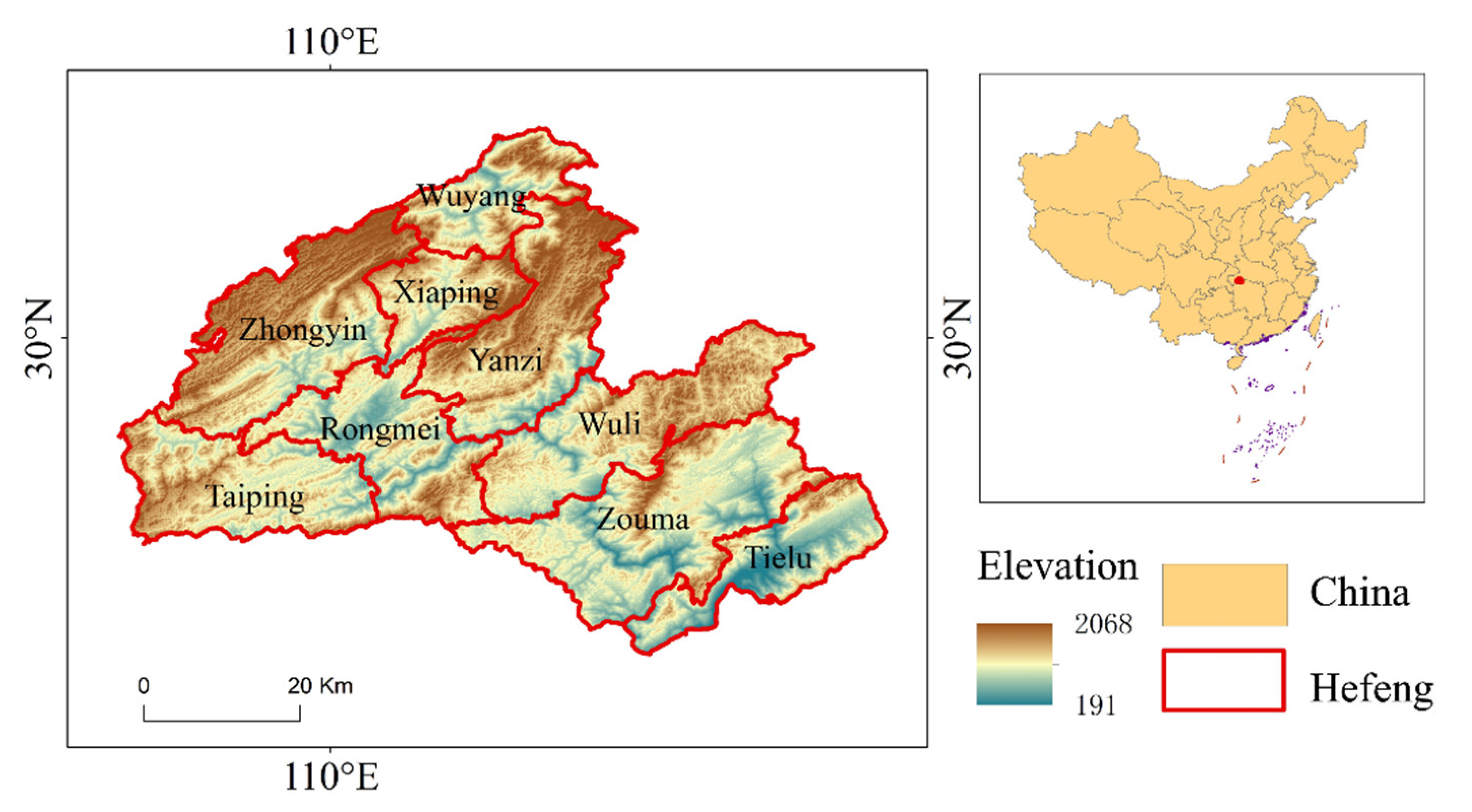
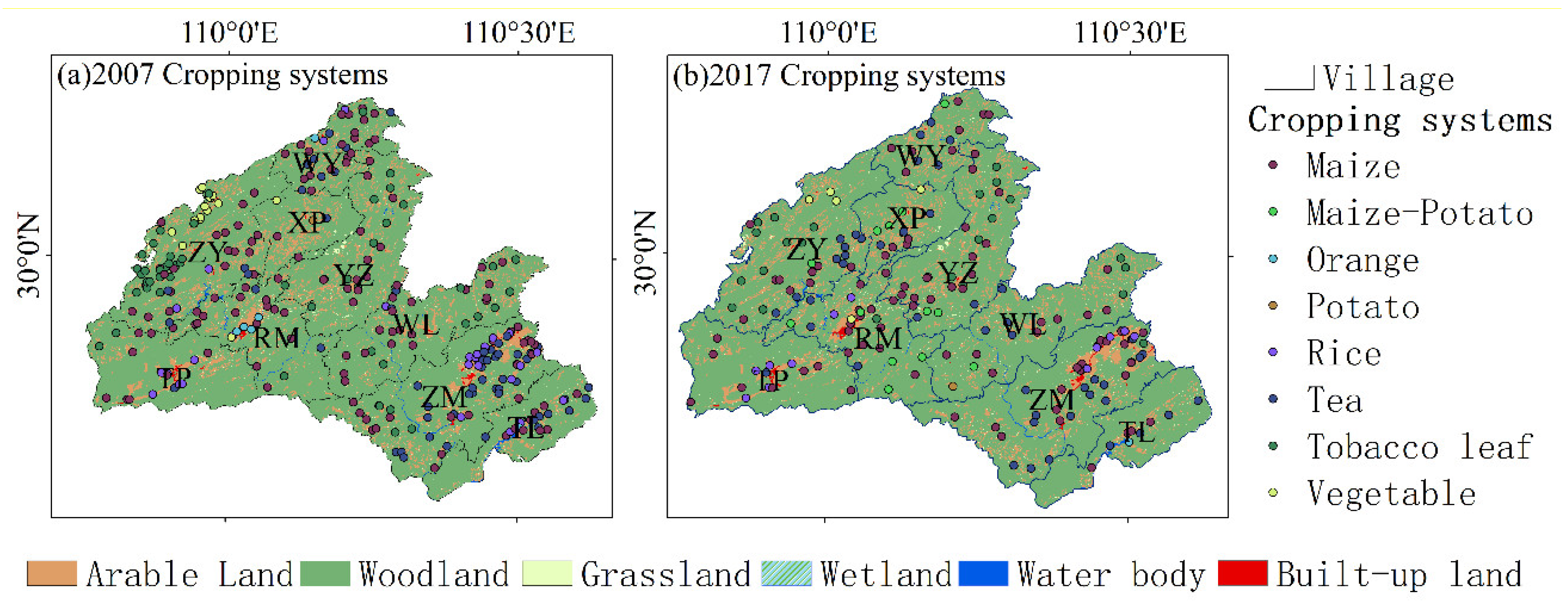


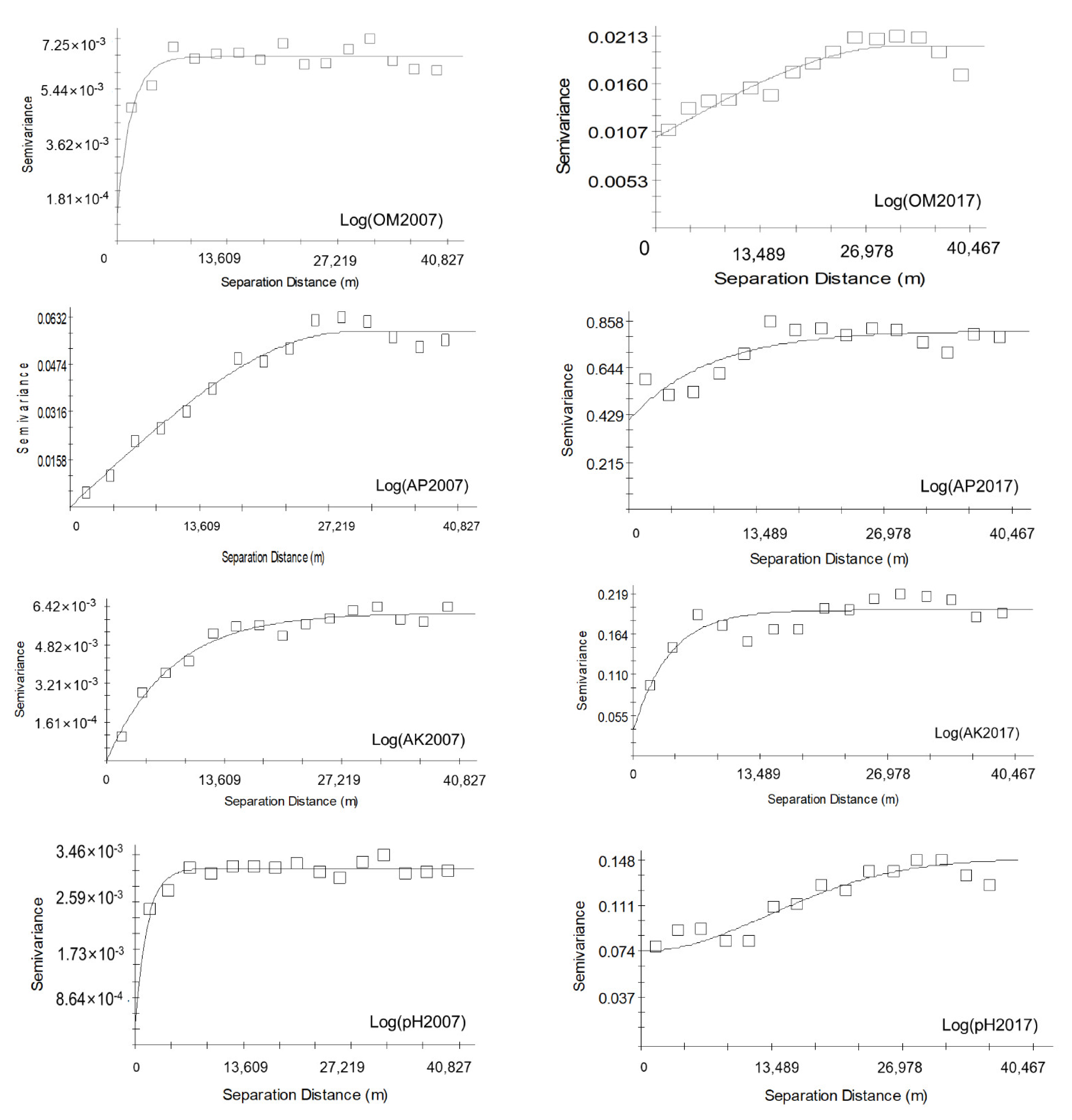
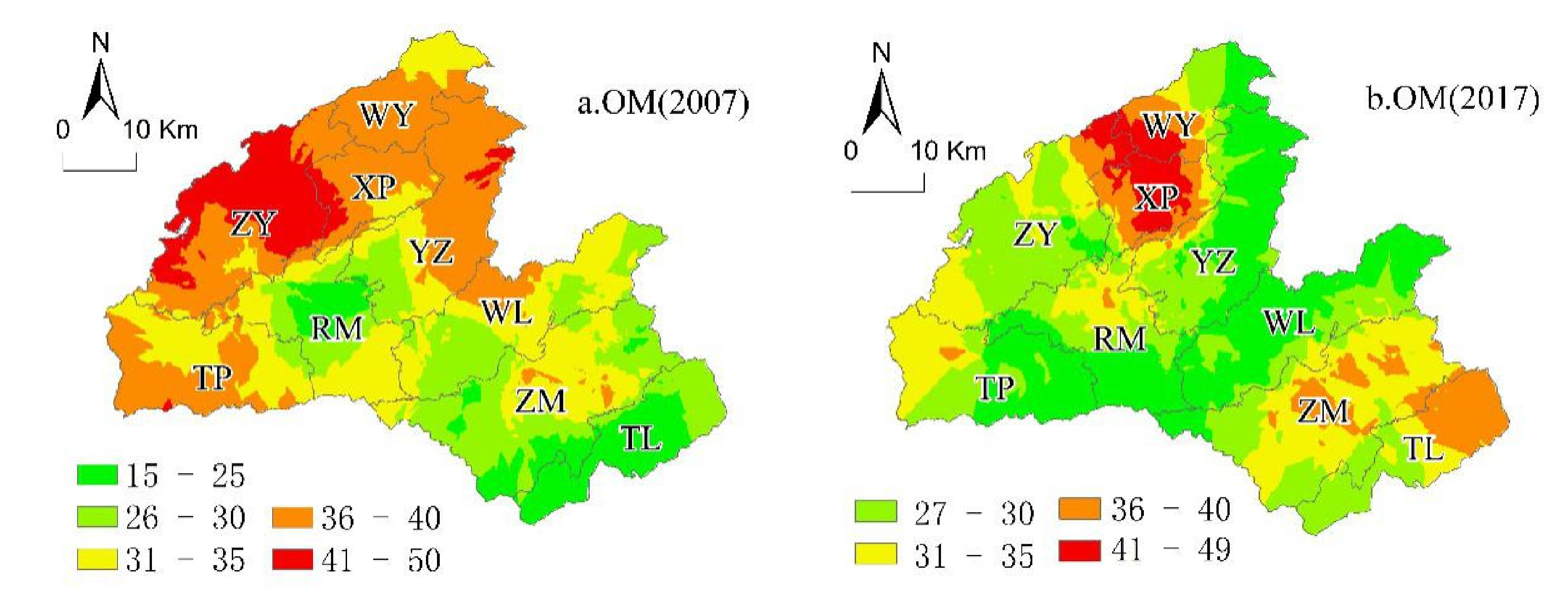
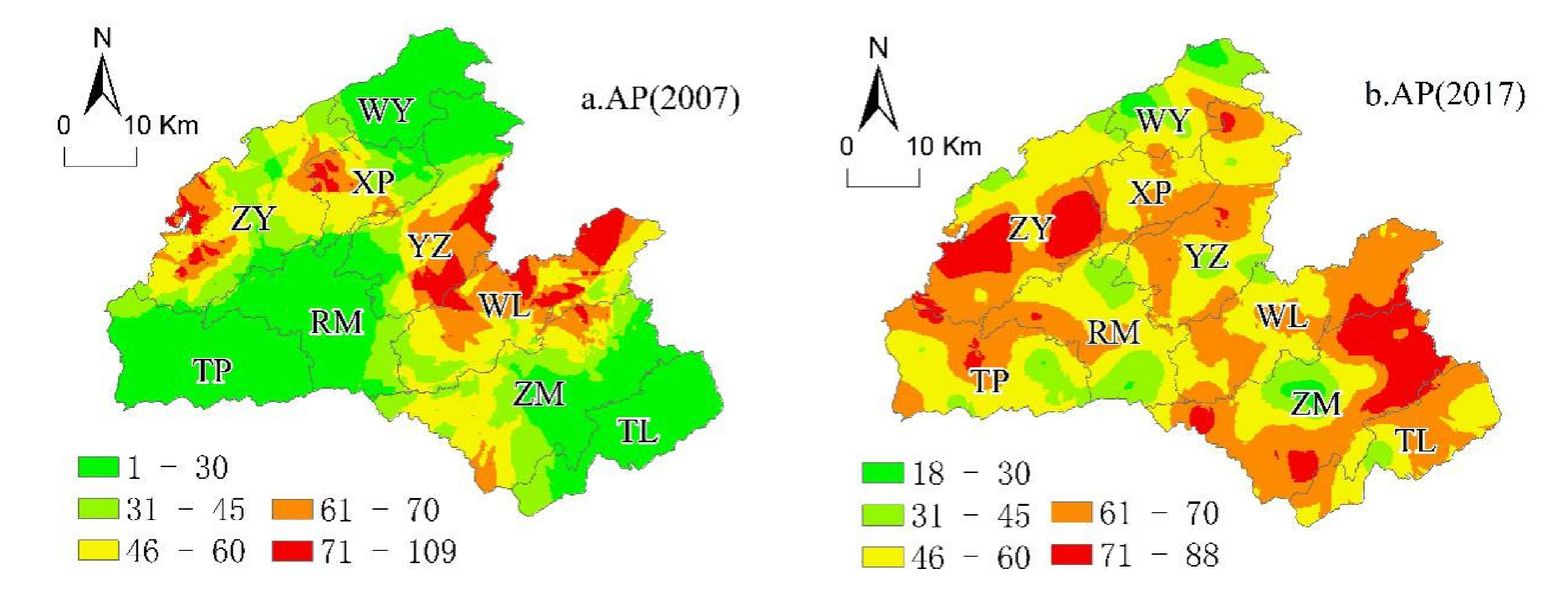
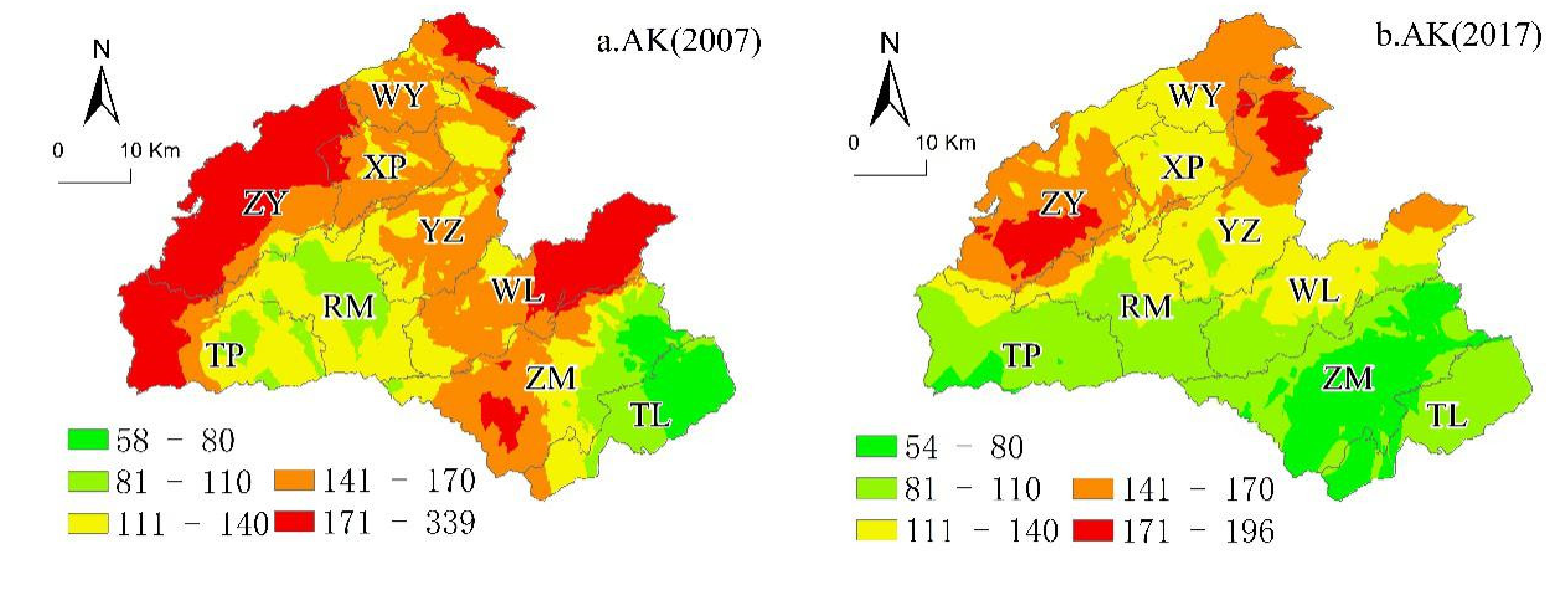
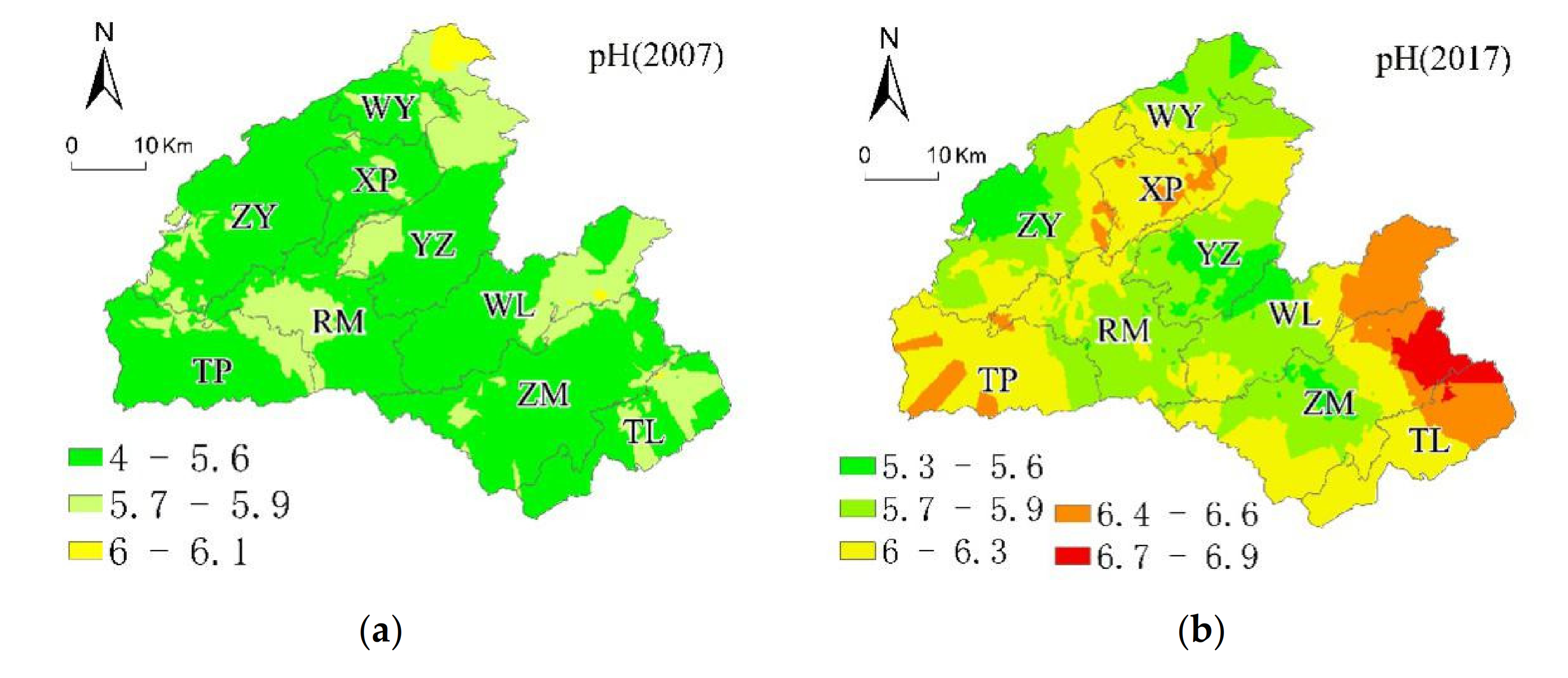
| Soil Property | Year | RMSE | SEM | RMSS | MAE |
|---|---|---|---|---|---|
| OM | 2007 | 10.216 | 0.0021 | 1.2248 | 9.545 |
| 2017 | 8.629 | 0.0260 | 1.0046 | 9.295 | |
| AP | 2007 | 35.687 | −0.0206 | 0.9843 | 36.354 |
| 2017 | 21.971 | −0.0193 | 0.8969 | 28.803 | |
| AK | 2007 | 68.447 | −0.0216 | 0.9236 | 88.789 |
| 2017 | 55.984 | −0.0037 | 0.8401 | 66.949 | |
| pH | 2007 | 0.903 | 0.0034 | 0.997 | 0.956 |
| 2017 | 0.8034 | 0.0059 | 1.119 | 0.831 |
| Level of pH | pH | Level of AP, AK, and OM | AP | AK | OM |
|---|---|---|---|---|---|
| Extremely acidic | <4.5 | Very low | <3 | <30 | <6 |
| Very acidic | 4.5~5.0 | Low | 3~5 | 30~50 | 6~10 |
| Acidic | 5.0~5.5 | Lower-middle | 5~10 | 50~100 | 10~20 |
| Slightly acidic | 5.5~6.0 | Upper-middle | 10~20 | 100~150 | 20~30 |
| Neutrality | 6.0~7.9 | High | 20~40 | 150~200 | 30~40 |
| Very high | >40 | >200 | >40 |
| Year | Mean | Maximum | Min | SD | CV (%) | Skewness | Kurtosis | K–Sp | |
|---|---|---|---|---|---|---|---|---|---|
| OM (g/kg) | 2007 | 33.64 | 59.60 | 3.40 | 11.79 | 34.83 | 0.09 | −0.23 | <0.01 |
| 2017 | 35.49 | 55.60 | 13.64 | 9.03 | 25.44 | 0.02 | −0.28 | <0.01 | |
| AP (mg/kg) | 2007 | 39.56 | 158.10 | 0.10 | 37.60 | 76.46 | −0.68 | 0.99 | <0.01 |
| 2017 | 58.51 | 89.40 | 6.10 | 21.23 | 36.28 | 0.02 | −0.28 | <0.01 | |
| AK (mg/kg) | 2007 | 147.82 | 352.00 | 17.00 | 82.56 | 56.09 | −0.40 | −0.20 | <0.01 |
| 2017 | 118.02 | 250.00 | 10.00 | 62.97 | 51.35 | −0.24 | −0.08 | <0.01 | |
| pH | 2007 | 5.36 | 7.08 | 4.00 | 0.85 | 15.87 | 0.16 | 0.45 | <0.01 |
| 2017 | 5.99 | 7.75 | 4.63 | 0.77 | 12.88 | 0.04 | −0.07 | <0.01 |
| pH | OM | AP | AK | ||
|---|---|---|---|---|---|
| pH_2007 | 1 | −0.110 | 0.185 ** | −0.062 | pH_2017 |
| OM_2007 | −0.099 | 1 | 0.001 | 0.017 | OM_2017 |
| AP_2007 | −0.017 | 0.192 ** | 1 | 0.035 | AP_2017 |
| AK_2007 | 0.087 | 0.245 ** | 0.241 ** | 1 | AK_2017 |
| Topographic Factors | Year | OM | AP | AK | pH |
|---|---|---|---|---|---|
| Elevation | 2007 | −0.197 ** | −0.043 * | 0.305 ** | −0.012 |
| 2017 | −0.334 ** | −0.121 * | 0.408 ** | −0.089 | |
| Slope | 2007 | −0.037 | −0.159 * | −0.015 | −0.182 |
| 2017 | −0.021 | −0.154 ** | −0.175 ** | −0.038 | |
| Topographic relief | 2007 | −0.071 | 0.114 | 0.062 | −0.032 |
| 2017 | −0.022 | −0.151 * | −0.173 ** | −0.039 | |
| Profile curvature | 2007 | −0.070 | −0.120 | −0.005 | −0.183 |
| 2017 | −0.022 | −0.153 ** | −0.175 ** | −0.038 | |
| Planform curvature | 2007 | −0.028 | −0.219 * | 0.022 | −0.227 ** |
| 2017 | −0.015 | −0.114 | −0.074 | −0.128 * |
| Soil Textures | 2007 | 2017 | ||||||
|---|---|---|---|---|---|---|---|---|
| OM (g/kg) | AP (mg/kg) | AK (mg/kg) | pH | OM (g/kg) | AP (mg/kg) | AK (mg/kg) | pH | |
| Light loam | 36.96 | 37.93 | 201.31 | 5.51 | 35.11 | 59.45 | 119.50 | 6.06 |
| Sandy loam | 35.77 | 36.42 | 181.21 | 5.12 | 41.94 | 59.60 | 134.92 | 5.55 |
| Sandy soil | 30.46 | 33.12 | 123.82 | 5.18 | 43.33 | 56.42 | 108.67 | 6.38 |
| Medium loam | 38.67 | 42.09 | 179.72 | 5.29 | 37.72 | 59.66 | 113.57 | 5.88 |
| ANOVA (F values) | 6.68 ** | 0.50 | 7.75 ** | 1.03 | 2.18 | 0.02 | 0.29 | 1.48 |
| Years | 0.003 | 9.585 * | 61.097 ** | 146.878 ** | ||||
| Cropping Systems | 2007 | 2017 | ||||||
|---|---|---|---|---|---|---|---|---|
| OM (g/kg) | AP (mg/kg) | AK (mg/kg) | pH | OM (g/kg) | AP (mg/kg) | AK (mg/kg) | pH | |
| Maize | 34.46 | 44.12 | 178.46 | 5.3 | 35.90 | 57.44 | 125.41 | 5.93 |
| Maize–Potato | 32.48 | 77.86 | 127.08 | 5.18 | 38.19 | 46.85 | 112.62 | 6.02 |
| Orange | 26.15 | 31.62 | 111.82 | 5.39 | 31.60 | 61.65 | 62.00 | 5.73 |
| Potato | 28.68 | 78.84 | 142.5 | 5.41 | 36.55 | 66.00 | 104.00 | 5.44 |
| Rice | 37.38 | 32.14 | 125.12 | 5.45 | 32.87 | 67.47 | 67.15 | 6.25 |
| Tea | 35.19 | 48.97 | 127.04 | 4.65 | 36.51 | 64.44 | 106.26 | 6.11 |
| Tobacco leaf | 36.63 | 62.45 | 250.02 | 5.29 | 33.97 | 56.71 | 149.85 | 5.77 |
| Vegetable | 43.79 | 41.89 | 239.55 | 4.96 | 38.64 | 58.72 | 132.17 | 6.33 |
| ANOVA (F values) | 20.64 ** | 22.48 ** | 100.20 ** | 43.43 ** | 0.52 | 1.42 | 2.80 * | 1.08 |
| Year | Soil Properties | Model | Nugget (C0) | Sill (C0 + C) | Nugget/Sill | Range (m) | R2 | RSS | Moran’s I | Z | FD |
|---|---|---|---|---|---|---|---|---|---|---|---|
| 2007 | Log (OM) | S | 0.010 | 0.020 | 0.498 | 41,673.142 | 0.860 | 2.23 × 10−5 | 0.235 *** | 8.17 | 1.94 |
| 2017 | E | 0.004 | 0.008 | 0.500 | 22,320.000 | 0.833 | 1.15 × 10−3 | 0.243 *** | 2.35 | 1.98 | |
| 2007 | Log (AP) | E | 0.000 | 0.058 | 0.002 | 32,200.000 | 0.776 | 1.37 × 10−4 | 0.142 *** | 4.92 | 1.834 |
| 2017 | E | 0.407 | 0.815 | 0.499 | 25,800.000 | 0.679 | 5.84 × 10−2 | 0.203 * | 161 | 1.91 | |
| 2007 | Log (AK) | E | 0.021 | 0.059 | 0.350 | 15,630.000 | 0.862 | 1.44 × 10−6 | 0.318 ** | 1.92 | 1.98 |
| 2017 | E | 0.032 | 0.197 | 0.165 | 11,460.000 | 0.718 | 4.19 × 10−3 | 0.316 *** | 4.81 | 1.95 | |
| 2007 | Log (pH) | G | 0.0002 | 0.001 | 0.143 | 34,467.811 | 0820 | 6.19 × 10−7 | 0.401 ** | 2.12 | 1.99 |
| 2017 | G | 0.0739 | 0.149 | 0.497 | 34,069.439 | 0.875 | 1.24 × 10−3 | 0.274 *** | 3.15 | 1.99 |
Publisher’s Note: MDPI stays neutral with regard to jurisdictional claims in published maps and institutional affiliations. |
© 2021 by the authors. Licensee MDPI, Basel, Switzerland. This article is an open access article distributed under the terms and conditions of the Creative Commons Attribution (CC BY) license (http://creativecommons.org/licenses/by/4.0/).
Share and Cite
Li, Q.; Gu, F.; Zhou, Y.; Xu, T.; Wang, L.; Zuo, Q.; Xiao, L.; Liu, J.; Tian, Y. Changes in the Impacts of Topographic Factors, Soil Texture, and Cropping Systems on Topsoil Chemical Properties in the Mountainous Areas of the Subtropical Monsoon Region from 2007 to 2017: A Case Study in Hefeng, China. Int. J. Environ. Res. Public Health 2021, 18, 832. https://doi.org/10.3390/ijerph18020832
Li Q, Gu F, Zhou Y, Xu T, Wang L, Zuo Q, Xiao L, Liu J, Tian Y. Changes in the Impacts of Topographic Factors, Soil Texture, and Cropping Systems on Topsoil Chemical Properties in the Mountainous Areas of the Subtropical Monsoon Region from 2007 to 2017: A Case Study in Hefeng, China. International Journal of Environmental Research and Public Health. 2021; 18(2):832. https://doi.org/10.3390/ijerph18020832
Chicago/Turabian StyleLi, Qing, Fenlan Gu, Yong Zhou, Tao Xu, Li Wang, Qian Zuo, Liang Xiao, Jingyi Liu, and Yang Tian. 2021. "Changes in the Impacts of Topographic Factors, Soil Texture, and Cropping Systems on Topsoil Chemical Properties in the Mountainous Areas of the Subtropical Monsoon Region from 2007 to 2017: A Case Study in Hefeng, China" International Journal of Environmental Research and Public Health 18, no. 2: 832. https://doi.org/10.3390/ijerph18020832
APA StyleLi, Q., Gu, F., Zhou, Y., Xu, T., Wang, L., Zuo, Q., Xiao, L., Liu, J., & Tian, Y. (2021). Changes in the Impacts of Topographic Factors, Soil Texture, and Cropping Systems on Topsoil Chemical Properties in the Mountainous Areas of the Subtropical Monsoon Region from 2007 to 2017: A Case Study in Hefeng, China. International Journal of Environmental Research and Public Health, 18(2), 832. https://doi.org/10.3390/ijerph18020832





